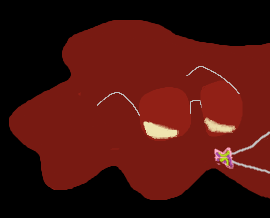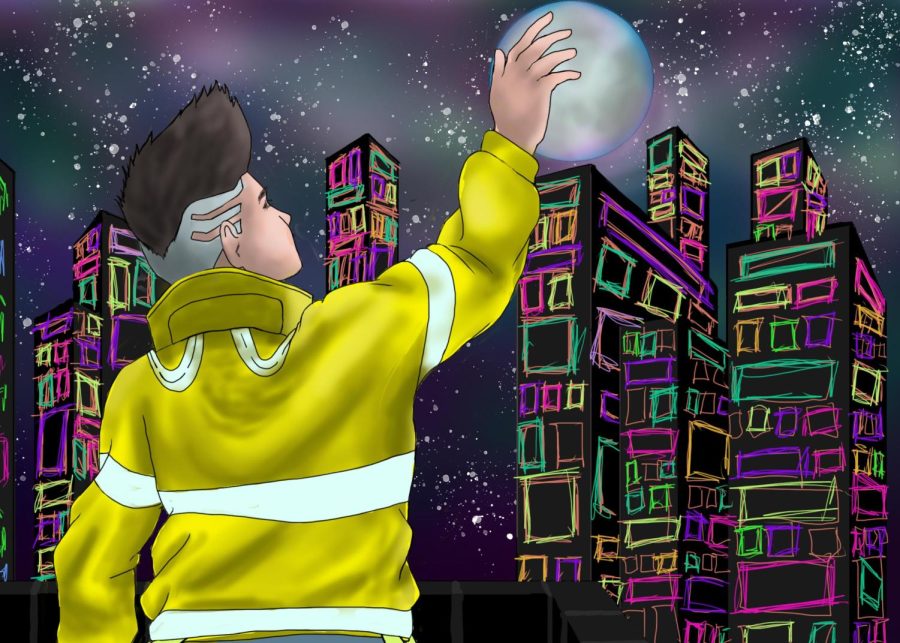Review: ‘Cyberpunk: Edgerunners’ tragic warning of dystopic future
Main character of “Cyberpunk: Edgerunners,” David Martinez, is a tragic character that tries to live outside his means for other people instead of looking out for himself.
October 24, 2022

-Spoiler Warning-
Skyscrapers, neon lights, thumping music, street-hardened citizens and a host of socioeconomic inequalities—this is Night City, home of the powerful mega corporations and the no-nonsense street gangs. It’s also the setting of “Cyberpunk: Edgerunners,” an R-rated Netflix original anime that was released on Sept. 13.
“Cyberpunk: Edgerunners” is a love letter to the source material, the 2020 video game “Cyberpunk 2077.” Studio Trigger, the animation studio, and CD Projekt Red, the game developer and publisher of the anime, worked in tandem to perfectly replicate the environment, culture and feel of Night City. Locations featured in the anime can be found in the game, as well as cybernetic upgrades, certain enemies, songs and characters like Rogue and Wakako.
The anime is a coming-of-age story for David Martinez, a 17-year-old, impoverished street kid who joined an edgerunner crew after his overworked mom died in a gang drive-by. Not only does he struggle with the capitalist colonialism nightmare that is Night City, but he also struggles to gain power and find his place.
The main cast features the no-nonsense edgerunner crew: the leader Maine, the extra muscle and Maine’s lover Dorio, the master netrunner Kiwi, the foul-mouthed and violent Rebecca, her brother and class clown Pilar and the solemn and secretive Lucy.
Fans of the anime are crying out for a second season after being left with tears streaming down our faces thanks to the finale. However, I believe the story was beautifully told in the allotted 10 episodes and that there doesn’t need to be a second season. My only gripe is that I wish there would have been more context between episodes six and seven.
I’m sure I’m not alone in saying that watching the first episode was completely jarring, especially as someone that had not played “Cyberpunk 2077” prior to watching the anime. I struggled to understand the elements of Night City and its technology, but not its culture. Mega corporations hold all the power while everyone else is left fighting for scraps below the high-rises. The culture is very much a worse version of today’s America, except with better technology.
I watched the anime a second time after picking up the game and understood many more references. “Cyberpunk: Edgerunners” has to be the most loyal media adaption I have had the pleasure of experiencing.
The characters are somewhat trope-heavy and predictable, but it was the execution of these tropes that made the story interesting. One thing I saw coming was David’s downfall, which made it even more excruciating to watch unfold. Night City is an unforgiving environment that claims victims to its culture every day. David is one of those victims, wanting to become stronger and make a name for himself in the city.
After Maine dies in a traumatic and spectacular fashion in episode six, David takes his place as leader of the edgerunner crew and bulks up by replacing most of his organic body with cyberware. I was one of the many people that were probably yelling “What are you doing?!” at David when we see him in episode seven after a time jump. This innate need for strength and recognition is what ultimately leads to his tragic end. Maine was meant to be a cautionary tale to David of what reaching for more and more power can do to a person.
Cyberware has become synonymous with power in this society obsessed with body modifications. It gives strength and abilities to people that wouldn’t be achievable through any natural means. David gains this power after installing a rare spinal implant called the Sandevistan and discovers he has a high tolerance for cyberware after being able to use the powerful device 10 times in one day—an amount that would kill a normal person or drive them to a mental disorder called cyberpsychosis.
In episode eight, Lucy notices that David is exhibiting symptoms of cyberpsychosis, mirroring the beginning of Maine’s descent into madness, and urges him to downgrade his cyberware. High tolerance or not, the human body is simply not meant to hold all those implants and be able to operate them.
In a YouTube video by TFC Tech, he theorizes how cyberpsychosis could be real by using real-world science. The strongest theory is that the bandwidth of the human brain cannot handle all the inputs that excessive amounts of cyberware implants require.
“Every further input you put onto your brain would further melt your perception into a mess and fill your mind with undecipherable stimuli,” TFC Tech said. “What we see in the show is that as characters integrate more chrome into their bodies, they push themselves further and further along the line of finally passing into cyberpsychosis.”
David dooms himself to repeat the cycle that keeps swallowing Night City citizens whole by trying to live up to what his mom and Maine expected of him. Living for other peoples’ dreams is what ultimately got him killed, although in the best way possible: by the hands of Adam Smasher.
“Cyberpunk: Edgerunners” was not meant to have a happy ending. Some people consume media to escape the droll of everyday life, but this anime challenges us to look at our own society and gives us a grim depiction of what we could be headed towards. It’s a lesson in knowing one’s own limits and needing to escape a bad situation when the opportunity arises.








































































